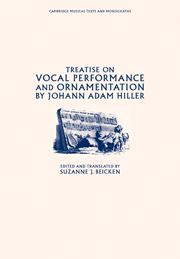Translator's introduction and commentary
Published online by Cambridge University Press: 22 September 2009
Summary
INTRODUCTION
Hiller's Anweisung zum musikalisch-zierlichen Gesange, offered here in English as “Treatise on Vocal Performance and Ornamentation,” is an important manual on performance practice worthy of being considered in the company of works by such familiar figures as Quantz, Leopold Mozart, C. P. E. Bach, Mattheson, and Marpurg, to name a few of the major eighteenth-century theorists. A masterly educator, Hiller initiated much improvement in the state of singing in Germany through his teaching and diverse activities as critic, composer, conductor, and music director in Leipzig. With this treatise and the earlier, more elementary tutor, the Anweisung zum musikalisch-richtigen Gesange of 1774 (“Treatise on Vocal Performance and Technique”), Hiller's goal was to educate German singers in the elaborate traditions of vocal art emulating the superior achievements of the Italians. As a pragmatic and insightful pedagogue, Hiller aimed at a presentation of performance practice material that would serve to raise the standards of singing in Germany. His 1774 treatise on “Richtigkeit” represents, according to John Butt, the “most radical break with traditional methods of ‘mainstream’ school singing.” Together with “the originality of his pedagogic approach,” this shows Hiller's “deep insight into the learning process – or, rather, his method conforms to a more ‘enlightened,’ psychological awareness of the pupil's natural learning abilities.”
- Type
- Chapter
- Information
- Publisher: Cambridge University PressPrint publication year: 2001



